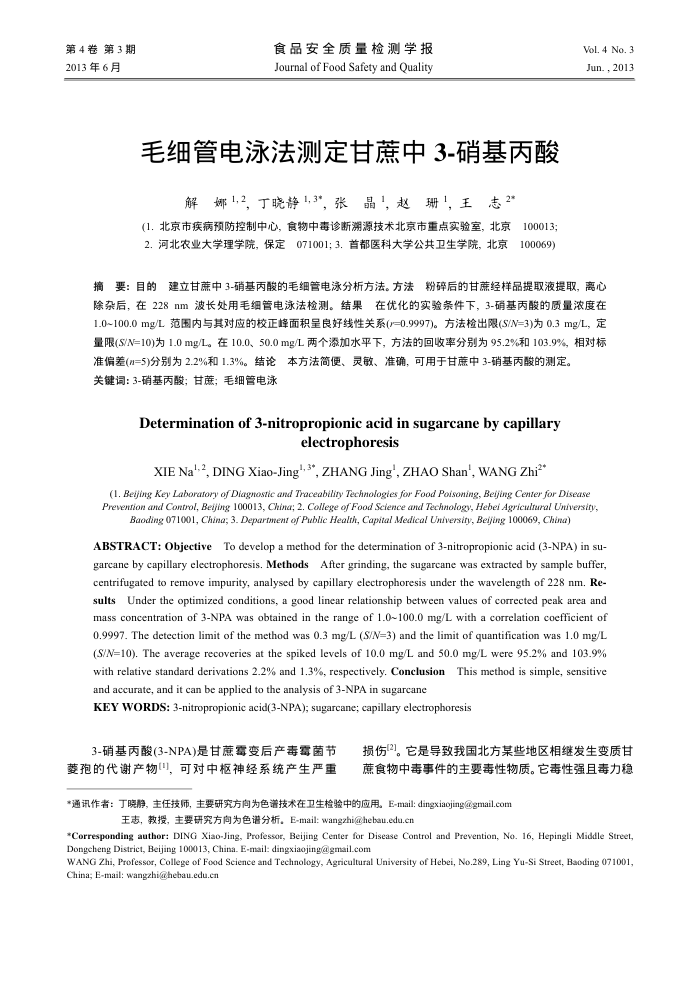您当前的位置:首页>论文资料>毛细管电泳法测定甘蔗中3-硝基丙酸
内容简介
 第4卷第3期 2013年6月
第4卷第3期 2013年6月食品安全质量检测学报 Journal of Food Safety and Quality
毛细管电泳法测定甘蔗中3-硝基丙酸
解娜1,2,丁晓静1,3*,张晶",赵珊1,王志2*
(1.北京市疾病预防控制中心,食物中毒诊断溯源技术北京市重点实验室,北京100013; 2.河北农业大学理学院,保定071001;3.首都医科大学公共卫生学院,北京100069)
Vol. 4 No. 3 Jun.,2013
摘要:目的建立甘蔗中3-硝基丙酸的毛细管电泳分析方法。方法粉碎后的甘蔗经样品提取液提取,离心除杂后,在228nm波长处用毛细管电泳法检测。结果在优化的实验条件下,3-硝基丙酸的质量浓度在 1.0~100.0mg/L范围内与其对应的校正峰面积呈良好线性关系(r=0.9997)。方法检出限(S/N=3)为0.3mg/L,定量限(S/N=10)为1.0mg/L。在10.0、50.0mg/L两个添加水平下,方法的回收率分别为95.2%和103.9%,相对标
准偏差(n=5)分别为2.2%和1.3%。结论本方法简便、灵敏、准确,可用于甘蔗中3-硝基丙酸的测定。关键词:3-硝基丙酸;甘蔗;毛细管电泳
e
electrophoresis
XIE Na'.2, DING Xiao-Jing",3+, ZHANG Jing", ZHAO Shan',WANG Zhi2
(1. Beijing Key Laborartory of Diagnostic and Traceability Technologies for Food Poisoning, Bejing Center for Disease Prevention and Control, Bejing 100013, China; 2. College of Food Science and Technology, Hebei Agricultural Uriversity:
Baoding 071001, China; 3. Departmen of Public Health, Capital Medical Urhversity, Beijing 100069, China)
ABSTRACT: ObjectiveTo develop a method for the determination of 3-nitropropionic acid (3-NPA) in su-garcane by capillary electrophoresis. MethodsAfter grinding, the sugarcane was extracted by sample buffer, centrifugated to remove impurity, analysed by capillary electrophoresis under the wavelength of 228 nm. Re sultsUnder the optimized conditions, a good linear relationship between values of corrected peak area and mass concentration of 3-NPA was obtained in the range of 1.0~100.0 mg/L with a correlation coefficient of 0.9997. The detection limit of the method was 0.3 mg/L (S/N=3) and the limit of quantification was 1.0 mg/L(S/N=10). The average recoveries at the spiked levels of 10.0 mg/L and 50.0 mg/L were 95.2% and 103.9% with relative standard derivations 2.2% and 1.3%, respectively. ConclusionThis method is simple, sensitive and accurate, and it can be applied to the analysis of 3-NPA in sugarcane
KEY WORDS: 3-nitropropionic acid(3-NPA); sugarcane; capillary electrophoresi
3-硝基丙酸(3-NPA)是甘蔗霉变后产毒霉菌节菱孢的代谢产物",可对中枢神经系统产生严重
损伤。它是导致我国北方某些地区相继发生变质甘蓝食物中毒事件的主要毒性物质。它毒性强且毒力稳
*通讯作者:丁晚静,主任技师,主要研究方向为色谱技术在卫生检验中的应用。E-mail:dingxiaojing@gmail.com
王志,教授,主要研究方向为色谱分析。E-mail:wangzhi@hebau.edu.cn
*Corresponding author: DING Xiao-Jing, Professor, Beijing Center for Disease Control and Prevention, No. 16, Hepingli Middle Street, Dongcheng District, Beijing 100013, China. E-mail: dingxiaojing@gmail.con
WANG Zhi, Professor, College of Food Science and Technology, Agricultural University of Hebei, No.289, Ling Yu-Si Street, Baoding 071001, China; E-mail: wangzhi@hebau.edu.cn